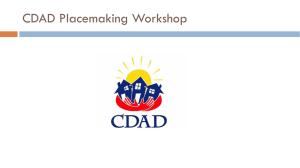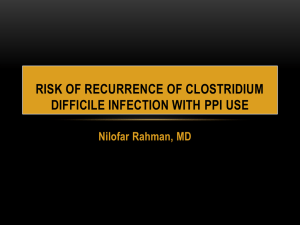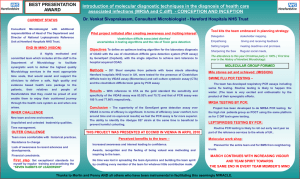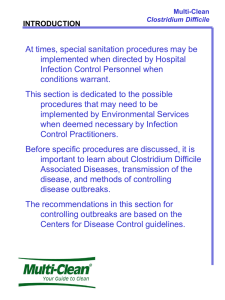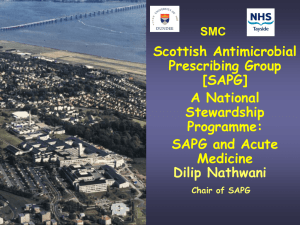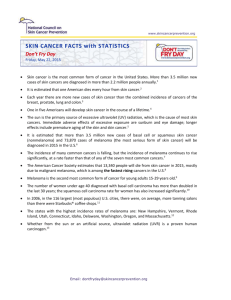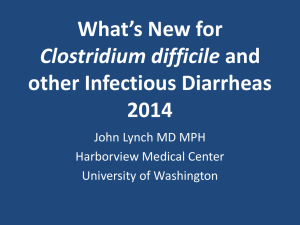Effect of antibiotic use, gastric-acid suppressive agents and
advertisement
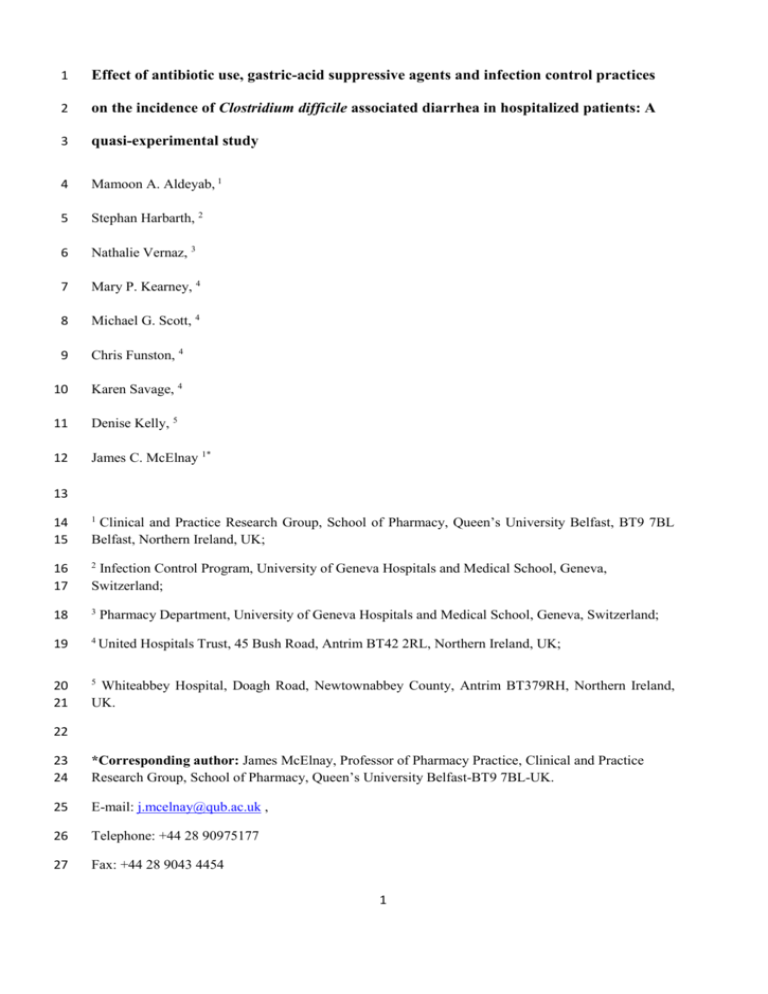
1 Effect of antibiotic use, gastric-acid suppressive agents and infection control practices 2 on the incidence of Clostridium difficile associated diarrhea in hospitalized patients: A 3 quasi-experimental study 4 Mamoon A. Aldeyab, 1 5 Stephan Harbarth, 2 6 Nathalie Vernaz, 3 7 Mary P. Kearney, 4 8 Michael G. Scott, 4 9 Chris Funston, 4 10 Karen Savage, 4 11 Denise Kelly, 5 12 James C. McElnay 1* 13 Clinical and Practice Research Group, School of Pharmacy, Queen’s University Belfast, BT9 7BL Belfast, Northern Ireland, UK; 14 15 1 16 17 2 18 3 Pharmacy Department, University of Geneva Hospitals and Medical School, Geneva, Switzerland; 19 4 United Hospitals Trust, 45 Bush Road, Antrim BT42 2RL, Northern Ireland, UK; 20 21 5 Infection Control Program, University of Geneva Hospitals and Medical School, Geneva, Switzerland; Whiteabbey Hospital, Doagh Road, Newtownabbey County, Antrim BT379RH, Northern Ireland, UK. 22 23 24 *Corresponding author: James McElnay, Professor of Pharmacy Practice, Clinical and Practice Research Group, School of Pharmacy, Queen’s University Belfast-BT9 7BL-UK. 25 E-mail: j.mcelnay@qub.ac.uk , 26 Telephone: +44 28 90975177 27 Fax: +44 28 9043 4454 1 28 Abstract 29 30 The objective of this study was to evaluate the effect of antimicrobial drug use, gastric-acid 31 suppressant agent use and infection control practices on the incidence of Clostridium difficile 32 associated diarrhea (CDAD) in a 426-bed general teaching hospital in Northern Ireland. The 33 study was retrospective and ecological in design. A multivariate ARIMA (time-series 34 analysis) model was built to relate CDAD incidence with antibiotic use, gastric-acid 35 suppressant agent use and infection control practices within the hospital over a five-year 36 period (February 2002- March 2007). The findings of this study showed that temporal 37 variation in CDAD incidence followed temporal variations in the use of second-generation 38 cephalosporins (average delay=2 months; variation of CDAD incidence=0.01/100 bed-days), 39 third-generation cephalosporin use (average delay=2 months; variation of CDAD 40 incidence=0.02/100 bed-days), fluoroquinolone use (average delay=3 months; variation of 41 CDAD incidence=0.004/100 bed-days), amoxicillin-clavulanic acid use (average delay=1 42 month; variation of CDAD incidence=0.002/100 bed-days) and macrolide use (average 43 delay=5 months; variation of CDAD incidence=0.002/100 bed-days). Temporal relationships 44 were also observed between CDAD incidence and use of histamine-2 receptor antagonists 45 (H2RAs; average delay=1 month; variation of CDAD incidence=0.001/100 bed-days; Table 46 3). The model explained 78% of the variance in the monthly incidence of CDAD. The 47 findings of this study highlight a causal relationship between certain classes of antibiotics, 48 H2RAs and CDAD incidence. The results of this research can help hospitals to set priorities 49 for restricting the use of specific antibiotic classes, based on the size-effect of each class and 50 the delay necessary to observe an effect. 51 Short running title: medication use, infection control and CDAD 52 2 53 54 Introduction 55 56 Clostridium difficile, a spore-forming gram-positive anaerobic bacillus, is a common 57 pathogen in secondary healthcare settings with gastrointestinal colonisation giving rise to 58 increased morbidity, mortality and healthcare costs (1). The clinical spectrum of Clostridium 59 difficile-associated diarrhea (CDAD) ranges from uncomplicated diarrhea to severe life- 60 threatening pseudomembranous colitis (2). Established risk factors for CDAD include host 61 factors, (for example, advanced age and comorbidities (3, 4)), poor infection control practices 62 (relating to the healthcare environment, healthcare workers’ hand-hygiene, etc.)(3, 5), 63 exposure to factors that disrupt the normal protective intestinal microflora (i.e. broad- 64 spectrum antibiotics) (6-8), and the use of gastric-acid suppressive agents i.e. proton pump 65 inhibitors (PPIs)(9-11) and histamine-2 receptor antagonists (H2RAs) (12). In a systematic 66 review, which was undertaken to summarise the strength of the evidence for a relationship 67 between antibiotic use and the occurrence of CDAD, most studies cited were limited in their 68 ability to establish a causal relationship due to the presence of bias, small sample sizes and 69 the inadequate control of confounding factors (13). The authors of the review concluded that 70 well-designed studies are needed to identify true risk factors for CDAD and to provide 71 reliable estimates of the strength of association (13). 72 73 The objective of the present study was to combine data on the use of antibiotic agents, proton 74 pump inhibitors and, H2RAs, and infection control practices in order to comprehensively 75 evaluate temporal relationships between these factors and CDAD incidence over time. Since 76 temporally sequenced observations on CDAD and antimicrobial drug use are not 3 77 independent, applying simple regression analysis would be inappropriate to evaluate such 78 data (14, 15). A time-series analysis was therefore used to transform our data into a series of 79 independent values and to examine the trends and autocorrelations over time, including 80 characteristics for each explanatory variable and the outcome of interest (CDAD incidence). 81 82 83 84 85 86 87 88 89 90 91 92 93 94 95 96 4 97 Methods 98 Setting and study period 99 The study was carried out in the Antrim Area Hospital in Northern Ireland, United Kingdom 100 (UK), a 426 bed district general teaching hospital serving a population of approximately 101 420,000. The hospital provides all acute, general medical and surgical services, supports a 102 range of outpatient facilities and acts as a center for the co-ordination of health service 103 provision throughout a defined geographical area in Northern Ireland. The present 104 retrospective investigation involved collecting data on a monthly basis on the usage of 105 antibiotics and, gastric-acid suppressive agents, and on infection control practices together 106 with the incidence of CDAD within the hospital over a five-year period (February 2002- 107 March 2007). The study was ecological in design. 108 Microbiology and pharmacy data 109 The number of CDAD cases (on a monthly basis) was obtained from the clinical 110 microbiology information system over the study period. Duplication was removed from these 111 data such that more than one positive C. difficile test from the same patient was considered as 112 a single episode if the positive tests were ≤ 28 days apart. Within the hospital laboratory, 113 clinical samples were processed according to routine microbiology procedures. The presence 114 of C. difficile was identified via the detection of toxins A and B directly from the faeces of 115 patients with colitis-like symptoms. The Microbiology laboratory utilises the Premier™ 116 Toxin A and B kit, an ELISA (Enzyme-Linked Immunosorbent Assay) technique; the 117 standard methodology supplied with the kit was used throughout the study period. 118 119 Prior to January 2005 it was hospital policy only to test samples of faeces for C. difficile 120 when this was specifically requested by the physician. From the beginning of January 2005, 5 121 in accordance with new government guidelines, the testing of faeces from all patients of 65 122 years of age and over with diarrhea was introduced, while physician requested testing 123 continued in patients of ≥ 2 years of age. 124 125 Bed occupancy data over the study period were obtained at monthly intervals to calculate the 126 incidence of CDAD per 100 bed-days. For the purpose of this study CDAD was defined as a 127 toxin positive test plus diarrhea (an increased number (2 or more) of watery/liquid stools (i.e. 128 type 6 and 7) that is greater than normal for the patient, within a duration of 24 hours) or 129 pseudomembranous colitis on sigmoidoscopy/colonoscopy or a histopathology diagnosis. The 130 definition excluded asymptomatic patients with either a positive C. difficile stool culture 131 and/or toxin assay, diarrhea associated with another cause and children less than 2 years. The 132 monthly quantities of each antibiotic delivered for patient care to each ward of the hospital 133 were obtained from the hospital pharmacy information system. These quantities were 134 converted into defined daily doses (DDDs) following the recommendations of the World 135 Health Organization (WHO) (16). The numbers of DDDs of individual antibiotics were then 136 grouped into classes belonging to group J01 (antibacterials for systemic use) of the 137 Anatomical Therapeutic Chemical (ATC) classification system from the WHO Collaborating 138 Center for Drug Statistics Methodology and were finally expressed as a number of DDDs per 139 100 bed-days (16). 140 141 142 143 6 144 Infection control practices 145 Data were also collected on the monthly quantities of chlorhexidine (liters) and alcohol-based 146 hand rub (ABHR/liters) dispensed, again using the hospital pharmacy information system. 147 These latter parameters were finally expressed as volumes per 100 bed-days. Additionally, 148 data relating to staffing levels of nurses/auxiliary nurses were collected on a monthly basis 149 over the five-year study period, and expressed as whole time equivalents per 100 bed-days. 150 151 Statistical analysis 152 Autoregressive integrated moving average (ARIMA) models, using the Box–Jenkins method 153 for analysis (17), were used to evaluate whether relationships existed between antibiotic use, 154 the use of gastric-acid suppressive agents and the level of infection control practices, and the 155 incidence of CDAD. Using multivariate transfer function models, the association between the 156 ‘explanatory’ time series of usage of antibiotics, H2RAs, PPIs and ABHR and the ‘response’ 157 time series of the monthly incidence density of CDAD, was assessed taking into account the 158 possible time delays (of up to 5 months) of the effects of the explanatory variables. 159 160 A transfer function model, which consists of modelling a time series as a function of its past 161 values and random errors, was built. For each individual series, an ARIMA model was 162 identified and fitted according to the Box and Jenkins methodology (17). At the outset, the 163 series were checked for stationarity (i.e. having a constant mean and variance) using the 164 augmented Dickey-Fuller test for unit roots. Following this, the model was identified by 165 determining the ARIMA model orders (p, d, q) using autocorrelation and partial 166 autocorrelation. The model parameters were then estimated by the unconditional least squares 167 method. Finally, the adequacy of the model was checked and statistical significance of the 7 168 parameters determined. Amongst different models, the most parsimonious one was chosen 169 with the fewest parameters, the lowest Akaike Information Criterion and the best R2. The 170 generated coefficient (R2) measures the overall fit of the regression line, i.e. the fraction of 171 the variance of the dependent variable explained by the regression model. 172 173 After identification of the multivariate transfer function models, the cross-correlation function 174 was determined by estimating the correlations between the series describing antibiotic, 175 H2RAs, PPIs and ABHR use at different time lags, and the CDAD series. Significance tests 176 for parameter estimates were used to eliminate the unnecessary terms in the model. A P value 177 of 0.05 was considered to be statistically significant. All statistical analyses were performed 178 using EViews 3 software (QMS, Irvine, CA, USA). 179 180 181 182 183 184 185 186 187 188 189 190 191 192 8 193 Results 194 195 Over the five-year study period, there were 393 CDAD cases identified out of a total of 196 203,296 admissions. The average observed monthly CDAD incidence was 0.06/100 bed-days 197 (range: 0.00 - 0.17). Trends in the use of each class of antibiotic and gastric-acid suppressive 198 agent are presented in Table 1. The use of some antibiotic classes remained constant during 199 the study period, whereas other classes, e.g. combinations of penicillins with beta-lactamase 200 inhibitors (mostly amoxicillin-clavulanic acid), macrolides and fluoroquinolones, showed a 201 significant increasing trend in their use. Similarly, analysis of the data showed a significant 202 positive trend for some infection control practices, i.e. number of samples tested for C. 203 difficile and nursing/auxiliary nursing levels, whereas other practices remained fairly stable 204 (Table 2). 205 206 Multivariate time series analysis showed significant relationships between the incidence of 207 CDAD and a number of potential explanatory variables. Statistically significant positive 208 relationships were observed for the use of second-generation cephalosporins, third-generation 209 cephalosporins, fluoroquinolones, amoxicillin-clavulanic acid, macrolides and H2RAs with 210 various time lags (Table 3). The model showed that temporal variations in CDAD incidence 211 followed temporal variations in second-generation cephalosporin use with an average delay of 212 two months. This means that, on average, an increase (or decrease) of second-generation 213 cephalosporin use by 1 DDD/100 bed-days resulted two months later in an increase (or 214 decrease) of the incidence of CDAD by 0.01/100 bed-days. Effects of different sizes with a 215 different delays were observed for third-generation cephalosporin use (average delay=2 216 months; variation of CDAD incidence=0.02/100 bed-days), fluoroquinolone use (average 217 delay=3 months; variation of CDAD incidence=0.004/100 bed-days), amoxicillin-clavulanic 9 218 acid use (average delay=1 month; variation of CDAD incidence=0.002/100 bed-days) and 219 macrolides use (average delay=5 months; variation of CDAD incidence=0.002/100 bed-days; 220 Table 3). Temporal relationships were also observed between CDAD incidence and use of 221 H2RAs (average delay=1 month; variation of CDAD incidence=0.001/100 bed-days; Table 222 3). No correlation was found between PPI use, nursing levels and infection control practices 223 and the incidence of CDAD. 224 225 Three stochastic terms were introduced into the model, i.e. an autoregressive term (AR) with 226 a lag time of 4 months, a moving average (MA) term with a lag time of one month and a 227 seasonal moving average term with lag time of 12 months (Table 3). Those terms reflected 228 auto-correlation in the incidence of CDAD, i.e. this incidence was related to the incidence 229 observed in the previous months. The determination coefficient (R2) of the final model was 230 0.78, i.e. 78 % of the variation in the monthly incidence of CDAD over the study period was 231 explained by the factors included in the model. Projections for Antrim Area Hospital on the 232 DDDs of the implicated agents and the numbers of patients needed to be treated to cause or 233 prevent one CDAD case at the hospital are presented in Table 4. 234 235 Graphical representations of the relationships between the monthly use of second-generation 236 cephalosporins, third-generation cephalosporins, fluoroquinolones, amoxicillin-clavulanic 237 acid, macrolides and H2RAs, versus the monthly incidence of CDAD are presented in Figure 238 1. In this, data were plotted using a 5-month moving average transformation, i.e. the value 239 plotted for a specific month is the average of the value observed this month, the two previous 240 months and the two following months. 10 241 Finally, a curve of the summed monthly use of all explanatory variables, taking into account 242 their respective lags, was constructed and plotted on the same graph as the monthly incidence 243 of CDAD (Figure 2). This showed the parallel nature of the relationship between these lagged 244 explanatory variables and the incidence of CDAD at the Antrim Area Hospital and provided 245 visual confirmation of the model. 246 247 248 249 250 251 252 253 254 255 256 257 258 259 260 261 262 263 264 265 266 11 267 Discussion 268 269 The main objective of this research was to model the impact of antibiotics, gastric-acid 270 suppressive agents and infection control practices on the incidence of CDAD in hospitalized 271 patients. The study showed temporal relationships between the use of certain antibiotic 272 classes and H2RAs, and the incidence of CDAD. The use of second-generation 273 cephalosporins, third-generation cephalosporins, fluoroquinolones, amoxicillin-clavulanic 274 acid and macrolides was positively correlated with the incidence of CDAD. The findings 275 were consistent with those reported by others in relation to the role of the antibiotics in 276 increasing CDAD incidence rates in hospitals (6-8, 13, 18-24). 277 278 Given the extensive background knowledge regarding the possible lines of evidence between 279 antimicrobial use in hospitals and resistance which were proposed by McGowan (25), we 280 were able to demonstrate cause-effect relationships which followed both increases and 281 decreases in antibiotic use. Although resistance of C. difficile to certain antibiotics may play a 282 part in CDAD development, the presumed predominant mechanism by which an 283 antimicrobial promotes C. difficile is by disrupting the indigenous microflora of the colon 284 which provides an important host defense against colonisation by, and overgrowth of, C. 285 difficile and other pathogens (8). Although clindamycin has been considered a high-risk 286 antibiotic for CDAD (8), no significant correlation between clindamycin exposure and the 287 incidence of CDAD was observed. A possible explanation of this could be the low volume of 288 use of this antibiotic in the hospital. 289 12 290 As previously reported by others (12), the results of this analysis showed a significant 291 correlation between the use of H2RAs and subsequent incidence of CDAD. This is 292 scientifically plausible since these agents suppress gastric acid increasing host susceptibility 293 to upper gastrointestinal tract infections (gastric acid is considered a major defence 294 mechanism against ingested pathogens) (12). Although a number of studies have 295 demonstrated an association between CDAD and the use of PPIs (9-11), our findings showed 296 that there was no such significant association, confirming similar findings in several other 297 studies (20, 26, 27). The reason why one group of the gastric-acid suppressive agents i.e. 298 H2RAs was positively correlated with the CDAD incidence while the other major class of 299 agents (i.e. PPIs), was not, remains unclear and requires further investigation. 300 301 In addition to antibiotic and H2RA use, the model included surrogate markers of infection 302 control practices i.e. the use of alcohol-based hand rub, chlorhexidine and number of samples 303 tested for C. difficile, together with the related factors of nurse/auxiliary nurse staffing levels. 304 None of these variables were statistically associated with the incidence of CDAD. These 305 findings confirm results published by Vernaz et al. (28) which demonstrated no association 306 between alcohol-based hand rub and incidence of CDAD. This finding is plausible due to the 307 fact that alcohol-based hand rubs (and chlorhexidine) are not reliably effective against C. 308 difficile spores (29). The inclusion of alcohol-based hand rubs and chlorhexidine in the 309 analysis was, however, necessary as these products can select for C. difficile spores, due to 310 their lack of sporicidal activity and thus may in fact facilitate the spread of C. difficile as 311 hypothesised by some experts (30, 31). Within the present study there was, however, no 312 evidence of such facilitation. 313 13 314 The study design has several strengths, including the use of a robust analysis method which 315 allows a comprehensive evaluation of the temporal relationship between explanatory 316 variables and the incidence of CDAD. In addition, the study involved all patients hospitalized 317 during the study period. Furthermore, data were collected as part of routine hospital practice 318 and independently from the study, thus, selection and information bias are unlikely. At the 319 Antrim Area Hospital, infection control practices during the study period were in line with 320 national and international guidelines. The policies were implemented in all clinical areas and 321 there was an ongoing programme of audit of clinical practices, decontamination of clinical 322 equipment and environmental hygiene. 323 324 The study has some limitations. Firstly, since the study was ecological and observational in 325 design, it was not possible to control for different patient group characteristics and changes in 326 patient population and case-mix which may have affected the incidence of CDAD. Such 327 parameters may be involved in the 22% of the variance which was not explained by our 328 model. Secondly, antibiotic resistance patterns in relation to CDAD were not available for the 329 analysis as testing for CDAD antibiotic susceptibility was not a routine practice in the 330 hospital. However, second/third generation cephalosporins and fluoroquinolones (particularly 331 ciprofloxacin) have poor activity against C. difficile, and macrolides have demonstrated only 332 moderate activity against this pathogen (8, 32). Thirdly, specimen ribotyping to identify the 333 presence of the virulent C. difficile 027 ribotype was not carried out during the study period. 334 A sample ribotype survey was, however, carried out across Northern Ireland from September 335 to December 2006 (local data provided by Communicable Disease Surveillance Centre 336 Northern Ireland; CDSCNI); no cases of C. difficile 027 were identified. The first case of this 337 ribotype was reported in Ireland in 2007 (33). Finally, although it was not possible to control 338 for the change in the hospital CDAD screening policy which took place in January 2005, 14 339 clinical staff in the hospital have a high clinical awareness of the occurrence of CDAD, and as 340 such the risk of missed cases is low. 341 342 In conclusion, the present research attempted to clarify, in a comprehensive fashion, the 343 combined role of antibiotics, gastric-acid suppressive agents and infection control practices 344 on the incidence of CDAD. The findings of this study highlighted a potential causal 345 relationship between certain classes of antibiotics, H2RAs, and CDAD incidence. Whereas 346 there is a significant body of research supporting a cause-effect relationship between 347 antibiotic use and the incidence of CDAD, there is no consensus in relation to the association 348 between gastric-acid suppressive agent use and CDAD. More research is needed to 349 investigate the latter before limiting their use in hospitals. The findings confirm that the 350 restriction of specific antibiotics could reduce the incidence of CDAD, but further prospective 351 work is required to investigate the feasibility of restricting those antibiotics and into 352 appropriate alternatives during restriction periods. The results of this research, however, can 353 help hospitals to set priorities for restricting the use of specific antibiotic classes, based on the 354 size-effect of each class and the delay necessary to observe an effect. Measuring the delay 355 required to observe an effect following the restriction/use of particular antibiotics, which was 356 possible using the time-series analysis technique, could be a possible way forward in 357 determining the optimal time required for an antibiotic restriction policy. 358 359 360 361 362 363 15 364 365 366 367 368 References 369 370 371 372 373 374 375 1- Thompson, I. 2008. Clostridium difficile-associated disease: update and focus on non-antibiotic strategies. Age Ageing. 37:14-8. 2- McMaster-Baxter, N.L., and D.M. Musher.2007. Clostridium difficile: recent epidemiologic findings and advances in therapy. Pharmacotherapy. 27: 1029-39. 3- McFarland, L.V. 2008.Update on the changing epidemiology of Clostridium difficileassociated disease. Nat Clin Pract Gastroenterol Hepatol. 5:40-8. 376 4- Schwaber, M.J., A. Simhon, C. Block, V. Roval, N. Ferderber, and M. Shapiro. 2000. 377 Factors associated with nosocomial diarrhea and Clostridium difficile-associated 378 disease on the adult wards of an urban tertiary care hospital. Eur J Clin Microbiol 379 Infect Dis. 19:9-15. 380 5- Apisarnthanarak, A., J.E. Zack, J.L. Mayfield, J. Freeman, W.M. Dunne, J.R. Little, 381 L.M. Mundy, and V.J. Fraser. 2004. Effectiveness of environmental and infection 382 control programs to reduce transmission of Clostridium difficile. Clin Infect Dis. 383 39:601-2. 384 6- Muto, C.A., M. Pokrywka, K. Shutt, A.B. Mendelsohn, K. Nouri, K. Posey, T. 385 Roberts, K. Croyle, S. Krystofiak, S. Patel-Brown, A.W. Pasculle, D.L. Paterson, M. 386 Saul, and L.H. Harrison. 2005. A large outbreak of Clostridium difficile-associated 387 disease with an unexpected proportion of deaths and colectomies at a teaching 16 388 hospital following increased fluoroquinolone use. Infect Control Hosp Epidemiol. 389 26:273-80. 390 7- Baxter, R., G.T. Ray, and B.H. Fireman. 2008. Case-control study of antibiotic use 391 and subsequent Clostridium difficile-associated diarrhea in hospitalized patients. 392 Infect Control Hosp Epidemiol. 29:44-50. 393 8- Owens, R.C. Jr, C.J. Donskey, R.P. Gaynes, V.G. Loo, and C.A. Muto. 2008. 394 Antimicrobial-associated risk factors for Clostridium difficile infection. Clin Infect 395 Dis. 46 Suppl 1:S19-31. 396 9- Dial, S., K. Alrasadi, C. Manoukian, A. Huang, and D. Menzies. 2004. Risk of 397 Clostridium difficile diarrhea among hospital inpatients prescribed proton pump 398 inhibitors: cohort and case-control studies. CMAJ. 17:33-8. 399 10- Akhtar, A.J., and M. Shaheen. 2007. Increasing incidence of clostridium difficile- 400 associated diarrhea in African-American and Hispanic patients: association with the 401 use of proton pump inhibitor therapy. J Natl Med Assoc. 99:500-4. 402 11- Cadle, R.M., M.D. Mansouri, N. Logan, D.R. Kudva, and D.M. Musher. 2007. 403 Association of proton-pump inhibitors with outcomes in Clostridium difficile colitis. 404 Am J Health Syst Pharm. 64:2359-63. 405 12- Dial, S., J.A. Delaney, A.N. Barkun, and S. Suissa. 2005. Use of gastric acid- 406 suppressive agents and the risk of community-acquired Clostridium difficile- 407 associated disease. JAMA. 294:2989-95. 408 13- Thomas, C., M. Stevenson, and T.V. Riley. 2003. Antibiotics and hospital-acquired 409 Clostridium difficile-associated diarrhea: a systematic review. J Antimicrob 410 Chemother. 51:1339-50. 17 411 14- Shardell, M., A.D. Harris, S.S. El-Kamary, J.P. Furuno, R.R. Miller, and E.N. 412 Perencevich. 2007. Statistical analysis and application of quasi experiments to 413 antimicrobial resistance intervention studies. Clin Infect Dis. 45: 901–7. 414 15- Aldeyab, M.A., D.L. Monnet, J.M. López-Lozano, C.M. Hughes, M.G. Scott, M.P. 415 Kearney, F.A. Magee, and J.C. McElnay. 2008. Modelling the impact of antibiotic 416 use and infection control practices on the incidence of hospital-acquired methicillin- 417 resistant Staphylococcus aureus: a time-series analysis. J Antimicrob Chemother. 418 62:593-600. 419 16- WHO Collaborating Center for Drug Statistics Methodology. Guidelines for ATC 420 classifications and DDDs assignment. WHO Collaborating Center 2002; Oslo, 421 Norway. 422 423 424 17- Helfenstein, U. 1996. Box–Jenkins modelling in medical research. Stat Methods Med Res. 5: 3–22. 18- Kazakova, S.V., K. Ware, B. Baughman, O. Bilukha, A. Paradis, S. Sears, A. 425 Thompson, B. Jensen, L. Wiggs, J. Bessette, J. Martin, J. Clukey, K. Gensheimer, 426 G. Killgore, and L.C. McDonald. 2006. A hospital outbreak of diarrhea due to an 427 emerging epidemic strain of Clostridium difficile. Arch Intern Med. 166:2518-24. 428 19- Starr, J.M., H. Martin, J. McCoubrey, G. Gibson, I.R. Poxton. 2003. Risk factors for 429 Clostridium difficile colonisation and toxin production. Age Ageing. 32:657-60. 430 20- Pépin, J., N. Saheb, M.A. Coulombe, M.E. Alary, M.P. Corriveau, S. Authier, M. 431 Leblanc, G. Rivard, M. Bettez, V. Primeau, M. Nguyen, C.E. Jacob, and L. 432 Lanthier. 2005. Emergence of fluoroquinolones as the predominant risk factor for 18 433 Clostridium difficile-associated diarrhea: a cohort study during an epidemic in 434 Quebec. Clin Infect Dis. 41:1254-60. 435 21- McCusker, M.E., A.D. Harris, E. Perencevich, and M.C. Roghmann. 2003. 436 Fluoroquinolone use and Clostridium difficile-associated diarrhea. Emerg Infect 437 Dis. 9:730-3. 438 439 440 22- Braegger, C.P., and D. Nadal. 1994. Clarithromycin and pseudomembranous enterocolitis. Lancet. 343:241-2. 23- Guyot, A., M.D. Rawlins, and S.P. Barrett. 2000. Clarithromycin appears to be 441 linked with Clostridium difficile-associated diarrhoea in the elderly. J Antimicrob 442 Chemother. 46:642-3. 443 444 445 446 447 24- Al-Eidan, F.A., J.C. McElnay, M.G. Scott, and M.P. Kearney. 2000. Clostridium difficile-associated diarrhoea in hospitalised patients. J Clin Pharm Ther. 25:101-9. 25- McGowan, J.E. Jr. 1983. Antimicrobial resistance in hospital organisms and its relation to antibiotic use. Rev Infect Dis. 5: 1033-48. 26- Loo, V.G., L. Poirier, M.A. Miller, M. Oughton, M.D. Libman, S. Michaud, A.M. 448 Bourgault, T. Nguyen, C. Frenette, M. Kelly, A. Vibien, P. Brassard, S. Fenn, K. 449 Dewar, T.J. Hudson, R. Horn, P. René, Y. Monczak, and A. Dascal. 2005. A 450 predominantly clonal multi-institutional outbreak of Clostridium difficile-associated 451 diarrhea with high morbidity and mortality. N Engl J Med. 353:2442-9. 452 27- McFarland, L.V., J.E. Clarridge, H.W. Beneda, and G.J. Raugi. 2007. 453 Fluoroquinolone use and risk factors for Clostridium difficile-associated disease 454 within a Veterans Administration health care system. Clin Infect Dis. 45:1141-51. 19 455 28- Vernaz, N., H. Sax, D. Pittet, P. Bonnabry, J. Schrenzel, and S. Harbarth. 2008. 456 Temporal effects of antibiotic use and hand rub consumption on the incidence of 457 MRSA and Clostridium difficile. J Antimicrob Chemother. 62:601-7. 458 29- Vonberg, R.P., E.J. Kuijper, M.H. Wilcox, F. Barbut, P. Tüll, P. Gastmeier, 459 European C difficile-Infection Control Group, European Center for Disease 460 Prevention and Control (ECDC), P.J. van den Broek, A. Colville, B. Coignard, T. 461 Daha, S. Debast, B.I. Duerden, S. van den Hof, T. van der Kooi, H.J. Maarleveld, E. 462 Nagy, D.W. Notermans, J. O'Driscoll, B. Patel, S. Stone, and C. Wiuff. 2008. 463 Infection control measures to limit the spread of Clostridium difficile. Clin 464 Microbiol Infect. 14 Suppl 5:2-20. 465 466 30- Bartlett, J.G. 2006. Narrative review: the new epidemic of Clostridium difficileassociated enteric disease. Ann Intern Med. 145:758-64. 467 31- Gerding, D.N., C.A. Muto, and R.C. Jr. Owens. 2008. Measures to control and 468 prevent Clostridium difficile infection. Clin Infect Dis. 46 Suppl 1:S43-9. 469 32- Samore, M.H., L. Venkataraman, P.C. DeGirolami, M.M. Merrigan, S. Johnson, 470 D.N. Gerding, Y. Carmeli, and S. Harbarth. 2006. Genotypic and phenotypic 471 analysis of Clostridium difficile correlated with previous antibiotic exposure. 472 Microb Drug Resist. 12:23-8. 473 33- Long, S., L. Fenelon, S. Fitzgerald, N. Nolan, K. Burns, M. Hannan, L. Kyne, S. 474 Fanning, and D. Drudy. 2007. First isolation and report of clusters of Clostridium 475 difficile PCR 027 cases in Ireland. Euro Surveill. 12:E070426.3. 476 477 20 478 479 480 481 Table 1. Characteristics of the monthly antimicrobial, proton pump inhibitor and histamine-2 482 receptor antagonist use in the Antrim Area Hospital (February 2002-March 2007). Trend Average monthly use in Antimicrobial class (ATC group) DDD/100 bed-days (range) Coefficient P-value Tetracyclines (J01A) 0.85 (0.00-2.68) 0.01 0.013 Penicillins with extended spectrum (J01CA) 2.64 (1.29 - 5.32) -0.002 0.690 Beta-lactamase sensitive penicillins (J01CE) 0.86 (0.13 - 2.03) -0.007 0.031 Beta-lactamase resistant penicillins (J01CF) 3.17 (1.33– 6.28) 0.004 0.551 Combinations of penicillins including betalactamase inhibitors (J01CR) 24.50 (15.25 - 35.85) 0.267 0.043 First-generation cephalosporins (J01DB) 0.34 (0.01 - 0.92 ) -0.002 0.402 Second-generation cephalosporins (J01DC) 2.82(1.24 - 4.66) 0.014 0.539 Third-generation cephalosporins (J01DD) 0.61 (0.20 - 1.21) -0.001 0.517 Carbapenems (J01DH) 0.42 (0.00 – 3.00) 0.016 < 0.0001 Trimethoprim & derivatives (J01EA) 1.69 (0.73 - 2.67) -0.008 0.103 Combinations of sulfonamides and trimethoprim including derivatives (J01EE) 0.21 (0 - 1.00) 0.003 0.135 Macrolides (J01FA) 9.96 (5.64 - 21.37) 0.103 < 0.0001 Lincosamides (J01FF) 0.41 (0.00 - 1.20) 0.005 0.008 Aminoglycosides (J01GB) 1.03 (0.35 - 2.56) -0.0013 0.0004 Fluoroquinolones (J01MA)a 6.95 (3.35 - 12.05) 0.095 < 0.0001 Glycopeptide (J01XA) 1.18 (0.29 - 2.46) 0.019 < 0.0001 Steroid antibacterials (J01XC) 0.84 (0.19 – 2.05) 0.011 < 0.0001 Imidazole derivatives (J01XD) 4.25 (2.56 - 7.37) 0.03 0.001 Nitrofuran derivatives (J01XE) 0.26 (0.00 - 0.88) 0.004 0.001 21 Other antibacterials (J01XX) 0.24 (0.00 – 1.00) 0.006 < 0.0001 Antibacterials for systemic use, Total (J01) 63.32 (41.15- 88.46) 0.466 < 0.0001 Proton pump inhibitors (A02BC) 56.73 (23.28- 99.02) 1.279 < 0.0001 Histamine-2 receptor antagonists (A02BA) 7.99 (3.01- 40.69) 0.019 0.564 483 a 484 Table 2. Characteristics of the monthly infection control practices and related factors in the 485 Antrim Area Hospital (February 2002-March 2007). Mostly ciprofloxacin ( J01MA02) 486 Trend Monthly average Variable (measurement unit) (range) Coefficient P-value Infection control practices Alcohol-based hand rub (L/100 bed-days) 0.27 (0.00 - 4.01) -0.004 0.433 Chlorhexidine (L/100 bed-days) 1.22 (0.90 - 1.80) 0.005 0.094 Number of samples tested for C. difficile (no./100 bed- days) 2.98 (1.66 – 4.46) 0.0.029 < 0.0001 Nursing levels (whole time equivalent/100 bed-days). 3.12 (2.14 – 3.72) 0.009 < 0.0001 Auxiliary nursing levels (whole time equivalent/100 bed-days). 0.95 (0.54 – 1.18) 0.003 0.004 Other variables 487 488 489 490 491 492 493 494 495 496 22 Table 3. Multivariate time-series analysis model for monthly CDAD incidence (R2 = 0.78). Lag timea Coefficient (SE)b T-ratio P-value Second-generation cephalosporin use (DDD/100 bed-days) 2 0.010299 (0.003365) 3.061 0.0038 Third-generation cephalosporin use (DDD/100 bed-days) 2 0.018226 (0.006284) 2.900 0.0059 Fluoroquinolone use (DDD/100 bed-days) 3 0.003835 (0.001139) 3.367 0.0016 Amoxicillin-clavulanic acid use (DDD/100 bed-days) 1 0.001518 (0.000471) 3.223 0.0024 Macrolide use (DDD/100 bed-days) 5 0.001835 (0.000826) 2.221 0.0317 H2-receptor antagonist use (DDD/100 bed-days) 1 0.001035 (0.000335) 3.093 0.0035 AR c 4 0.775923 (0.059765) 12.983 < 0.0001 MA d 1 0.558183 (0.142460) 3.918 0.0003 SMAe 12 -0.933954 (0.016596) 56.277 < 0.0001 Term a Represents the delay necessary to observe the effect (in months). b Indicates the size and the direction of the effect. C AR, autoregressive term representing past incidence density of CDAD. d MA, moving average term representing past disturbances in the incidence density of CDAD. e SMA, seasonal moving average term, representing seasonality in past disturbances in the incidence density of CDAD. 23 Table 4. Projections for the Antrim Area Hospital on the required usage of DDDs and on the number of patients needed to be treated to cause or prevent the occurrence of one CDAD case. DDDsa No. patientsb Direction of effectc Lag timed Second-generation cephalosporin 97 14 Positive 2 Third-generation cephalosporin 55 8 Positive 2 Fluoroquinolone 261 37 Positive 3 Amoxicillin-clavulanic acid 659 94 Positive 1 Macrolide 545 78 Positive 5 966 nae Positive 1 Variable Antimicrobials Gastric-acid suppressive agents Histamine-2 receptor antagonists a Represents the number of Defined Daily Doses (DDD) needed on a given month to contribute to the occurrence of one CDAD case. b For antimicrobials, this represents number of patients needed to be treated on a given month to cause the occurrence of one CDAD case. This number was based on the assumption of an average treatment course of 7 DDD. c A positive direction of effect means that an increase in the mentioned DDDs and number of patients contributes to an increase of one CDAD case. d Represents the delay necessary to observe the effect (in months). e na, not applicable 24 Figure 1. Monthly CDAD incidence versus use of selected antibiotic classes and histamine-2 receptor antagonists, Antrim Area Hospital, February 2002-March 2007 ( cases/100 bed-days, 5-month moving average, left Y-axis; , CDAD, no. , Antimicrobial use and histamine-2 receptor antagonists, DDD/100 bed-days, 5-month moving average, right Yaxis); A) second-generation cephalosporins, B) third-generation cephalosporins, C) fluoroquinolones, D) amoxicillin-clavulanic acid, E) macrolides, and F) histamine-2 receptor antagonists 25 Figure 2. Monthly CDAD incidence ( ) and monthly sum of the lagged explanatory variables with their respective coefficients ( ) as identified in the multivariate time series analysis model: second-generation cephalosporins, third-generation cephalosporin use (lag of 2 months), fluoroquinolone use (lag of 3 months), amoxicillin-clavulanic acid use, histamine2 receptor antagonists (lag of 1 month), and macrolide use (lag of 5 months), Antrim Area Incidence CDAD per 100 bed-days Hospital, February 2002-March 2007. 26 27

